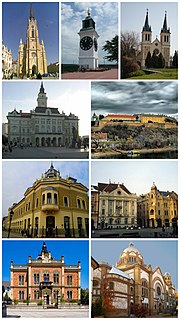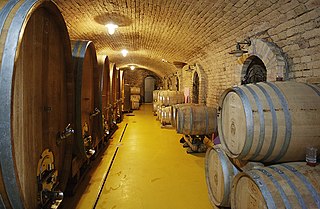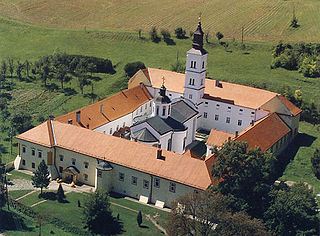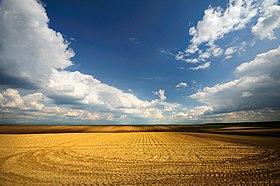
Novi Sad is the second largest city in Serbia and the capital of the autonomous province of Vojvodina. It is located in the southern portion of the Pannonian Plain on the border of the Bačka and Syrmia geographical regions. Lying on the banks of the Danube river, the city faces the northern slopes of Fruška Gora.

Vojvodina, officially the Autonomous Province of Vojvodina, is an autonomous province that occupies the northernmost part of Serbia. It lies within the Pannonian Basin, bordered to the south by the national capital Belgrade and the Sava and Danube Rivers. The administrative center, Novi Sad, is the second-largest city in Serbia.

Vršac is a city and the administrative centre of the South Banat District in the autonomous province of Vojvodina, Serbia. As of 2011, the city urban area had a population of 35,701, while the city administrative area had 52,026 inhabitants. It is located in the geographical region of Banat.

Syrmia is a region of the southern Pannonian Plain, which lies between the Danube and Sava rivers. It is divided between Serbia and Croatia. Most of the region is flat, with the exception of the low Fruška gora mountain stretching along the Danube in its northern part.

Irig is a town and municipality located in the Srem District of the autonomous province of Vojvodina, Serbia. The town has a population of 4,415, while Irig municipality has 10,866 inhabitants.

Šajkaška (Шајкашка) is a historical region in northern Serbia. It is southeastern part of Bačka, located in the Autonomous Province of Vojvodina. Territory of Šajkaška is divided among four municipalities: Titel, Žabalj, Novi Sad, and Srbobran. Historical center of Šajkaška is Titel.

Fruška gora is a mountain in Syrmia, administratively part of Serbia with a part of its western side extending into eastern Croatia. The area under Serbian administration forms the country's oldest national park. Sometimes it's also referred to as the Jewel of Serbia, due to its largely pristine landscape and protection effort, or the Serbian Mount Athos, it being the home of a large number of historical Serbian Orthodox monasteries.

Novi Bečej is a town and municipality located in the Central Banat District of the autonomous province of Vojvodina, Serbia. The town has a population of 13,133, while Novi Bečej municipality has 23,925 inhabitants.

Vojvodina is an autonomous region within Serbia located in the Pannonian plain, a region of central Europe. It shares borders with Romania in the east, Hungary in the north, Croatia in the west, and Bosnia and Herzegovina in the southwest. The southern border is administrative line to Šumadija and Western Serbia, Belgrade, and Southern and Eastern Serbia.

The Serbs of Vojvodina are the largest ethnic group in this northern province of Serbia. For centuries, Vojvodina was ruled by several European powers, but Vojvodina Serbs never assimilated into cultures of those countries. Thus, they have consistently been a recognized indigenous ethnic minority with its own culture, language and religion. According to the 2011 census, there were 1,311,776 Serbs in Vojvodina or 67.90% of the population of the province.

Stari Ledinci also known simply as Ledinci is a suburban settlement of Petrovaradin, Novi Sad, Serbia. The population of Stari Ledinci numbered 823 people in the 2002 census. Most of the inhabitants of the village are ethnic Serbs.

Kovilj is a suburban settlement of the city of Novi Sad, Serbia. The village has a Serb ethnic majority and its population numbering 5,599 people.

The Krušedol Monastery is a Serbian Orthodox monastery on the Fruška Gora mountain in the Syrmia region, northern Serbia, in the province of Vojvodina. The monastery is the legacy of the last Serbian despot family of Syrmia - Branković. Dedicated to the Annunciation to the Blessed Virgin Mary, it has been described as the "spiritual beacon" of Fruška Gora and "Second Studenica".

Vuk Grgurević Branković was a Serbian nobleman who was the titular despot of Serbia from 1471 until his death in 1485. He inherited the title of despot, by King Matthias Corvinus, and ruled most of present-day Vojvodina, under the overlordship of the Kingdom of Hungary. He is known in Serbian epic poetry for his valour and heroism, and is called Vuk the Fiery Dragon, Vuk the Dragon-Despot, or simply the Dragon; he commanded the Hungarian army in several of its battles against the Ottomans. He is considered the founder of Grgeteg monastery.

The Bešenovo Monastery was a Serb Orthodox monastery on the Fruška Gora mountain in the northern Serbian province of Vojvodina. It was located by the Čikoš stream, in the area of the Bešenovački Prnjavor village. During World War II, the monastery was destroyed in the bombing. At the moment it is being rebuilt.

The Divša Monastery, also known as Đipša (Ђипша), is a Serb Orthodox monastery on the Fruška Gora mountain in the northern Serbian province of Vojvodina. It is believed to have been founded by Despot Jovan Branković in the late 15th century. The earliest historical records about the monastery date to the second half of the 16th century. Owing to Turkish raids, the monastery was deserted in the 17th century; at the beginning of the 18th century, Dipša was mentioned as an appendage of the neighbouring Kuveždin monastery. Its old church underwent reconstruction in 1744, but the final alteration was made in 1762, when a new narthex was built. A chapel dedicated to the Mother of God was placed therein, upstairs. The iconostasis for the restored church was carried out by Teodor Stefanov Gologlavac in 1753.

The Staro Hopovo Monastery is a Serb Orthodox monastery on the Fruška Gora mountain in the northern Serbia, in the province of Vojvodina. According to tradition, the monastery was founded by Bishop Maksim. The first reliable mention of the monastery dates back to 1545/1546. It is on the basis of some data from 1751 that an earlier church with timber walls dedicated to St. Nicholas existed. The old church which had collapsed in an earthquake was in 1752 substituted with the extant single-nave building dedicated to St. Panteleimon. The woodcarving of the iconostasis of Staro Hopovo was completed in 1793, and the paintings by Janko Halkozović and Kuzman Kolarić.

The Privina Glava Monastery is a Serb Orthodox monastery on the Fruška Gora mountain in northern Serbia, in the province of Vojvodina. According to legend, Privina Glava was founded by a feudal lord whose name was Priba/Priva, in the 12th century while another attribution is the 15th century Srem despots of the Branković family. The earliest historical records about the monastery are dated in 1566/1567. The icons in the altar screen were painted by Andrej Šaltist in 1786, and the wall paintings by Kuzman Kolarić in 1791.

The Rakovac Monastery is a Serb Orthodox monastery on the Fruska Gora mountain in the northern Serbian province of Vojvodina. The monastery of Rakovac with its church dedicated to the Holy Healers Cosmas and Damian, as tradition has it, was founded by Raka Milošević, Chief Chamberlain to Despot Jovan Branković, according to a legend written in 1704. The legend states that Raka erected the monastery in 1498. The earliest historical records mentioning the monastery are dated to 1545–1546. Inside, there are fragments of the frescoes on the walls which date from the first half of the 16th century. The baroque bell-tower was adjoined in 1735, and the residential building gained its final, three-range shape in 1771. The icons on the baroque iconostasis were painted by Vasa Ostojić in 1763, while the wall paintings in the refectory are 1768 works of Amvrosije Janković.

The Središte Monastery is a Serb Orthodox monastery located in the Banat region, in the northern Serbian province of Vojvodina. The monastery is situated near the villages of Malo Središte and Veliko Središte, in the Vršac municipality. It was built in the late 15th century by Despot Jovan Brankovic.




























